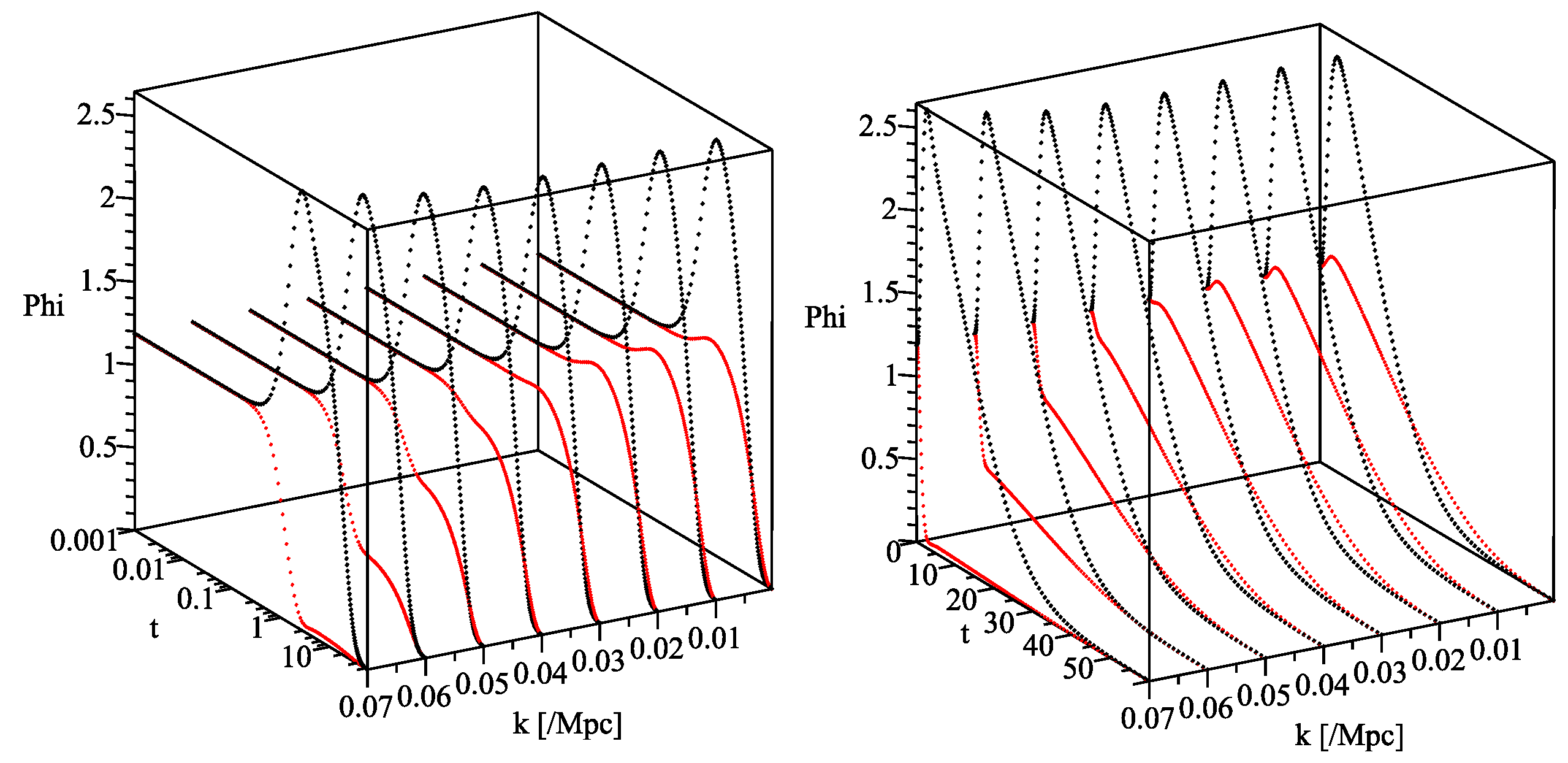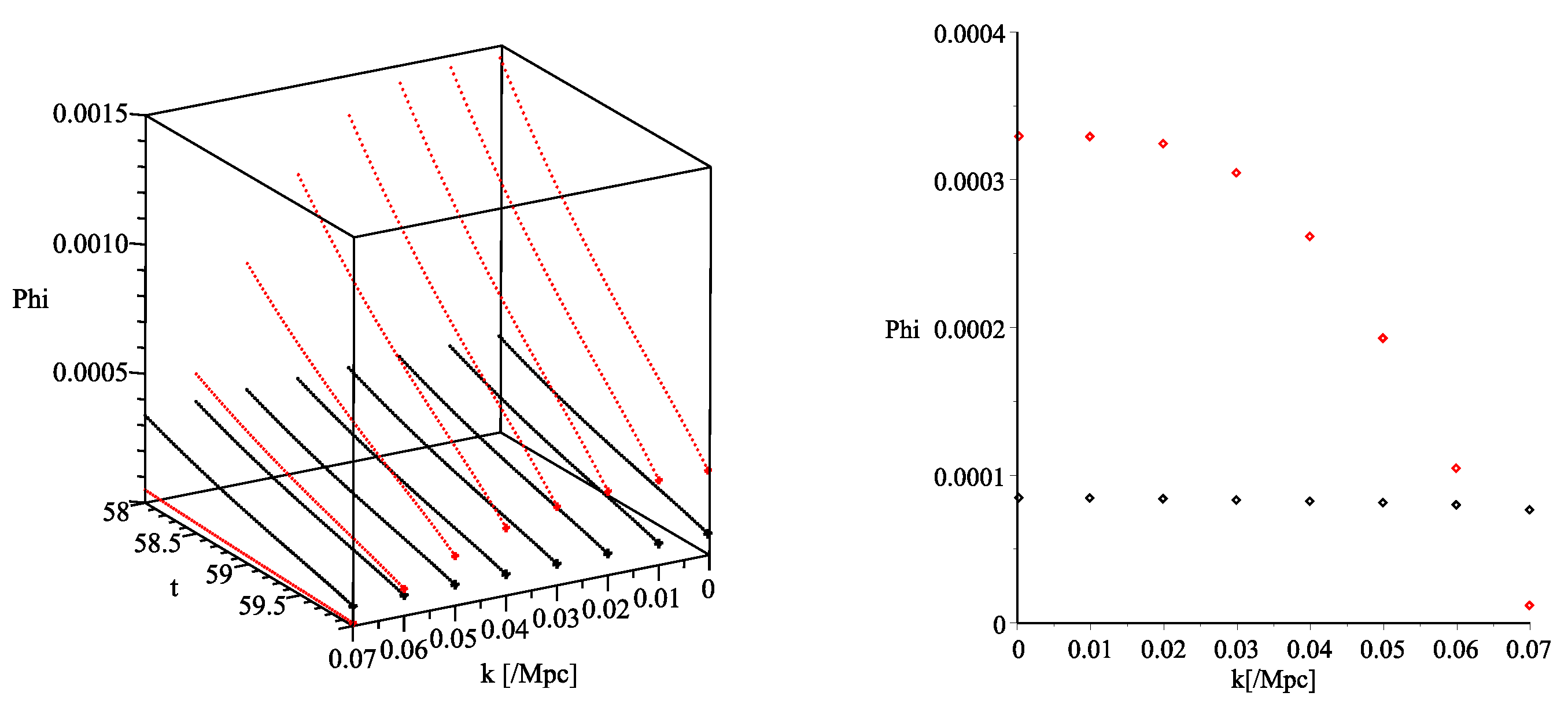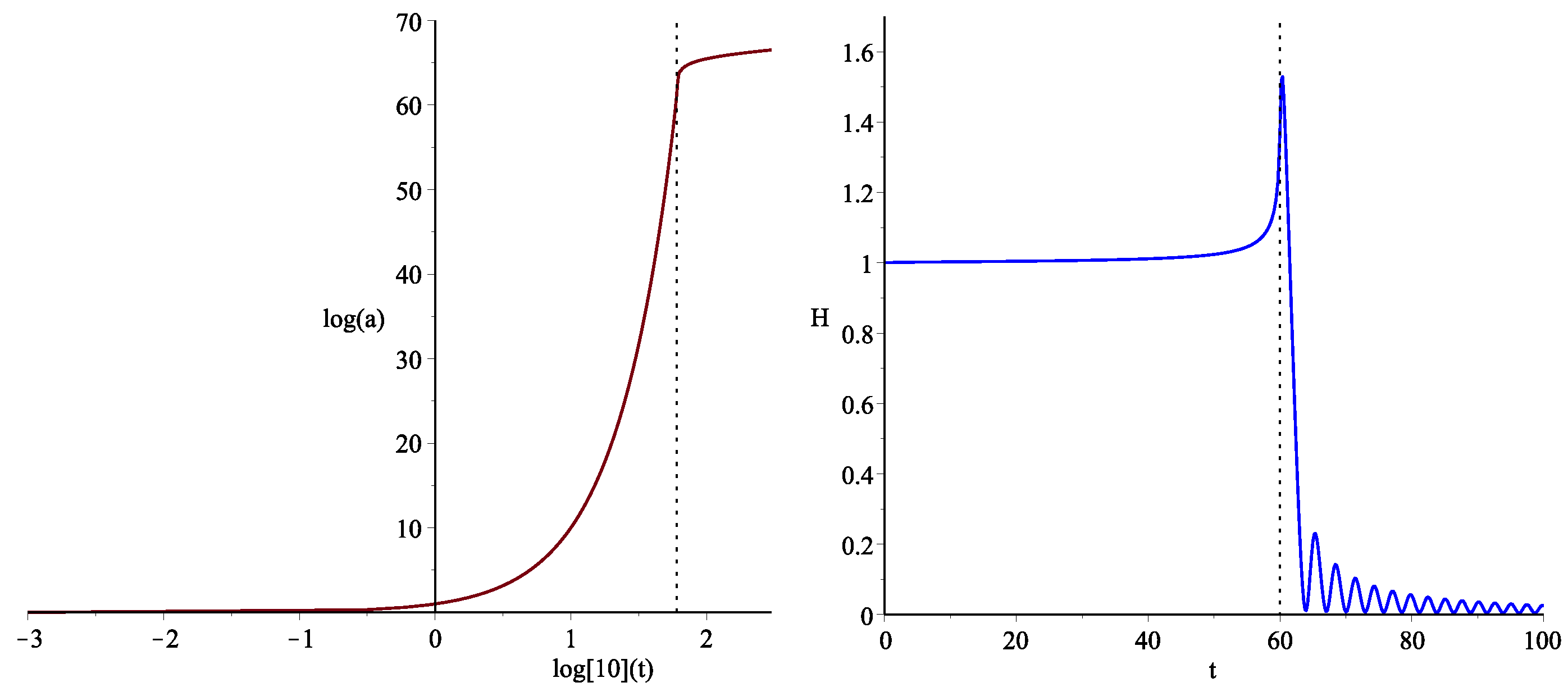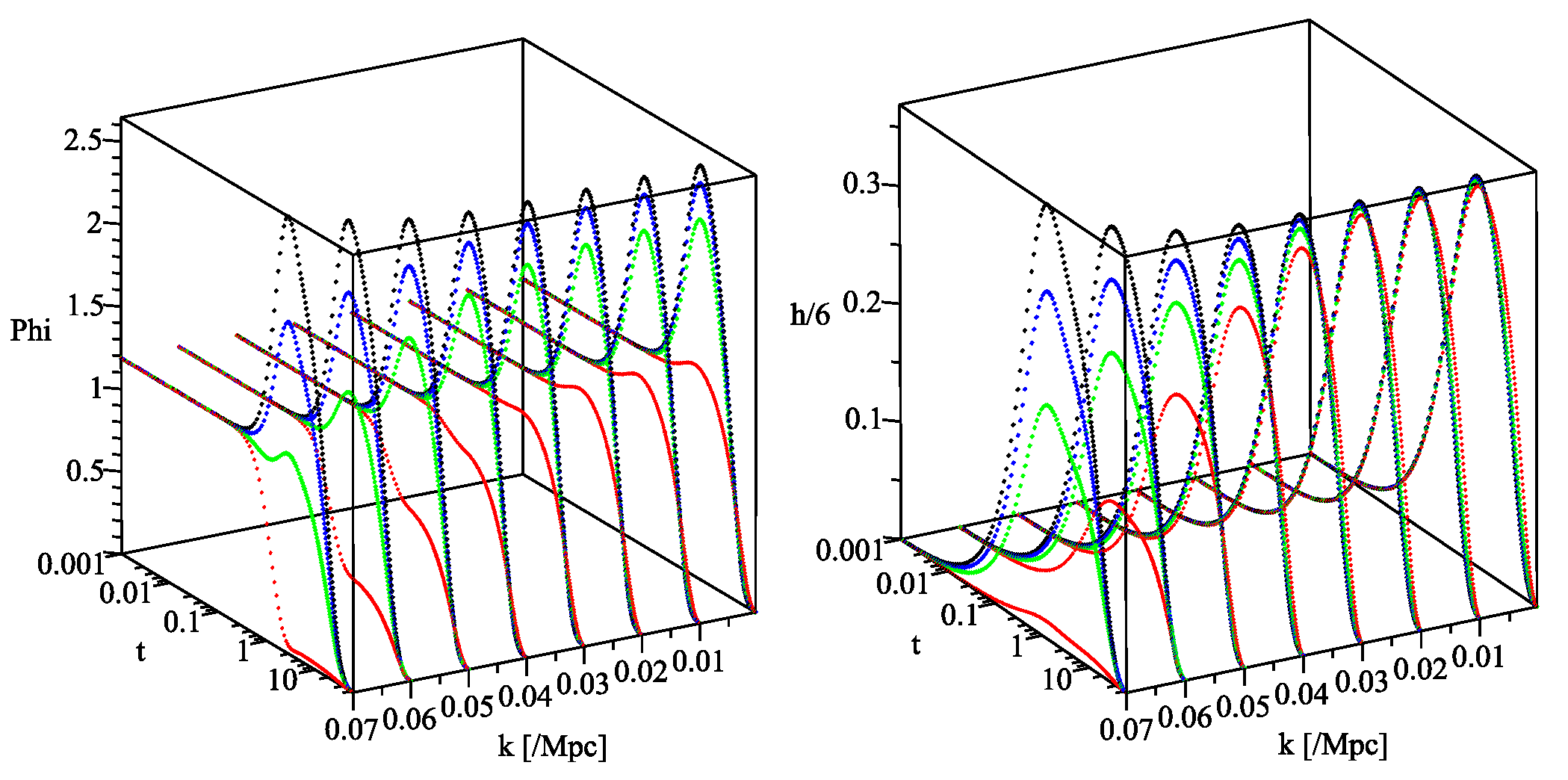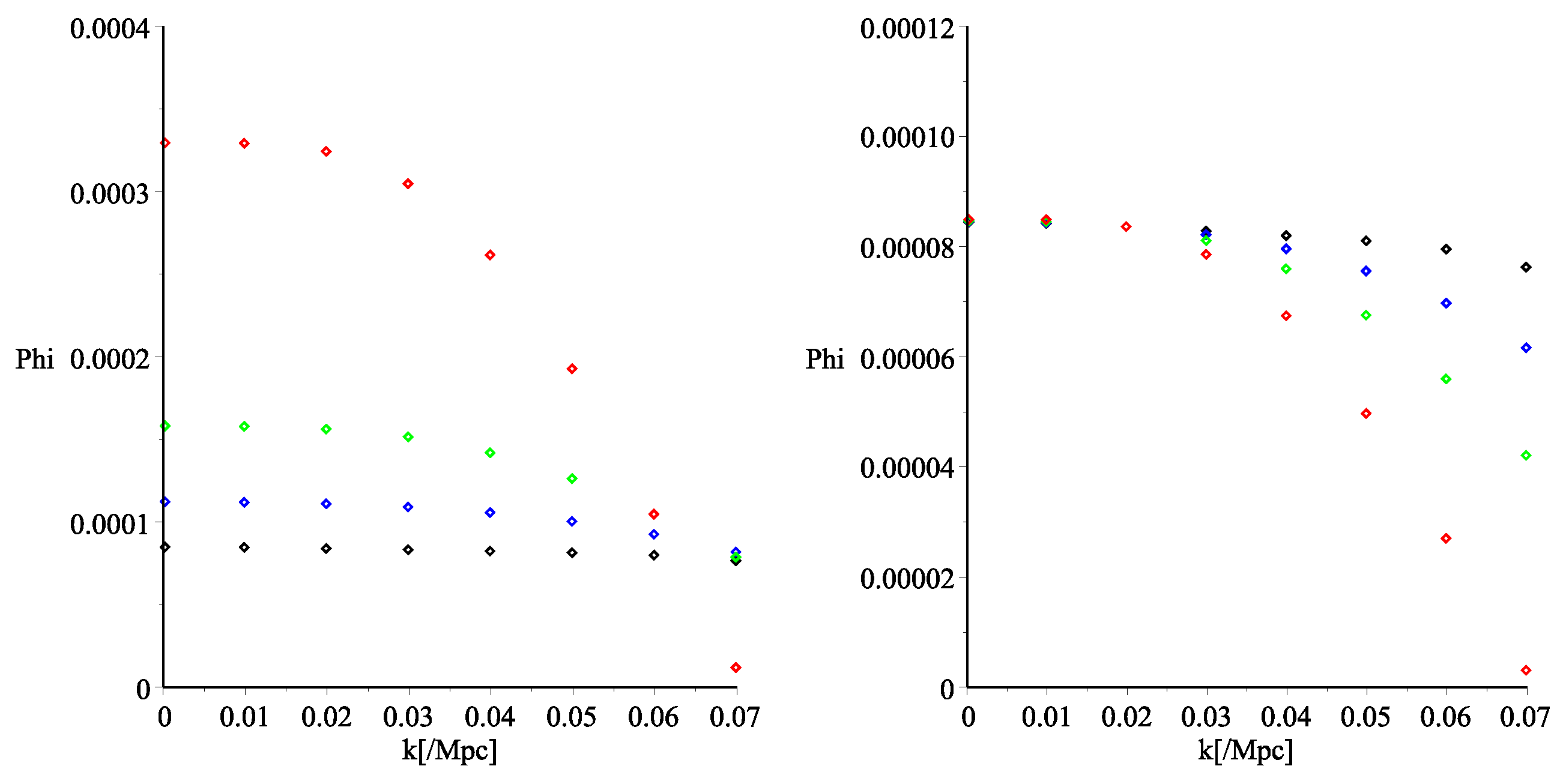1. Introduction and Summary
Inflation is an unbelievable idea proposed by Guth [
1], Sato [
2], and Starobinsky [
3] to solve the horizon and flatness problems, which claims that there was a period of exponential expansion in the universe before the big bang
1. Remarkably, if we genuinely embrace this concept, a significant portion of the universe we observe today originated from a region even smaller than the Planck length.
Going over the Planck-scale wall requires quantization of gravity with not only renormalizability but also background freedom. Defying the common perception in this research area, we have proposed asymptotically background-free quantum gravity [
5,
6,
7,
8,
9] as a theory with such properties and also a realistic inflationary dynamics. Its distinctive feature is that diffeomorphism invariance in the ultraviolet (UV) limit is described as a special conformal invariance [
10,
11,
12,
13,
14,
15,
16]. Since it is a gauge symmetry, it represents background freedom in which all different conformally-flat spacetimes are gauge equivalent. This symmetry is called BRST conformal invariance,
2 which was first found in two-dimensional quantum gravity [
17,
18,
19,
20] and then extended to four dimensions. The existence of this symmetry makes it possible to describe the world far beyond the Planck scale where scalar fluctuations dominate and no tensor ones.
Perturbation theory is formulated by introducing a dimensionless coupling constant
t that represents deviation from the conformal invariance. The asymptotic background freedom represents that nonperturbative fluctuations of the conformal mode in the gravitational field become dominant in the UV limit of
. In this paper, we investigate how the universe evolves and deviates from such a scale-invariant state. The moment when the conformal invariance is completely broken at a novel energy scale of quantum gravity,
, is called the “spacetime phase transition”. If we set this scale below the Planck scale, then the theory has an inflationary solution with the expansion time constant of order of the Planck mass [
21,
22,
23].
The goal of this study is to clarify how perturbations, or spacetime fluctuations, around the inflationary solution evolve, and to derive the primordial spectra that are the initial conditions of the current universe. It can be said that in the universe before inflation begins, quantum fluctuations of gravity are large and thus spacetime is not substantially fixed. As inflation begins, the fluctuations gradually decrease in amplitude, eventually reaching the magnitude suggested by observations of tiny anisotropies in the cosmic microwave background radiation (CMB) [
24,
25] until the time of the spacetime phase transition. Since fluctuations in gravity represent fluctuations in time and distance, the reduction of them implies that the universe becomes a real world where time and distance can be measured accurately
3.
In order to obtain the primordial spectrum, various nonlinear effects in the evolution of the fluctuations must be taken into account properly. The running coupling constant is one of these nonlinear effects, which is incorporated into the equations of motion by approximating it as a time-dependent mean field, as done in previous studies [
22,
23]. In this way, we show that the amplitude of the fluctuations reduces during inflation.
To determine the spectral pattern more accurately, we need to evaluate contributions from nonlinear terms, such as the exponential factor of the conformal mode existing in the Einstein–Hilbert action. The fluctuations dealt with here are of sizes that momentum dependence disappears as soon as inflation begins, but the nonlinear effects cannot be ignored in the early stage where the fluctuations are still large
4. One of the purposes of this research is to determine a system of nonlinear evolution equations of the fluctuations involving such effects.
Since it is a rather complicated equation system, we here simplify it by extracting most contributing parts of the nonlinear terms in comoving momentum space so that we can solve it numerically and quantify their effects, as will be described in
Section 4 and
Section 5. One of the results indicating that there is a large effect on the evolution of fluctuations is shown in
Figure 1 and
Figure 2, together with previous results from linear equations. Consequently, we confirm that the nonlinear terms have expected effects by which the initial scale invariance is maintained up to relatively-high momentum regions, as inferred in the previous works [
23].
In determining the spectrum, the presence of the physical infrared cutoff
plays an essential role. The sharp falloff in low multipole components of the CMB angular power spectrum is explained by this scale [
21]. Its wavelength is given by a comoving scale of the correlation length
. This means that most of the universe we see today was within the size of
before inflation.
Quantum gravity inflation suggests that the observed CMB anisotropy spectrum contains real quantum gravity effects. The guiding principles here are clear: diffeomorphism invariance and renormalizability. Thus the model gives life to the concept of inflation, aligning with Starobinsky’s perspective [
3]. Moreover, we expect that the primordial spectrum derived from the first principle will settle the Hubble tension [
27].
2. Renormalizable and Asymptotically Background-Free Quantum Gravity
The problems with Einstein’s theory of gravity are summarized in unrenormalizability and the existence of singularities. Therefore, a finite UV cutoff is usually introduced in the Planck scale to avoid such problems. This corresponds to thinking of spacetime discretized in the Planck length, and some researchers regard the length as a quantum of spacetime. However, introducing the UV cutoff breaks diffeomorphism invariance.
If we consider diffeomorphism invariance as a first principle, then we have to bring the cutoff to infinity, i.e., take the continuum limit. It implies that the theory is renormalizable. Being renormalizable is equivalent to having no singularity. The reason why the existence of singularities cannot be denied probabilistically is due to the fact that the Einstein–Hilbert action becomes finite for such singular spacetime configurations, because it does not contain the Riemann tensor
which controls the magnitude of curvature. A renormalizable quantum theory of gravity requires an action involving the Riemann tensor squared with correct sign. Since such an action is positively divergent for singularities, they are eliminated as unphysical
5. Furthermore, since the action becomes dimensionless, the corresponding coupling constant is also dimensionless and renormalizable [
28,
29,
30,
31].
Despite these excellent properties, it is generally known that another problem arises in such a theory. This is the so-called ghost problem. However, note here that the existence of ghost modes itself is not a problem. In fact, Einstein’s theory of gravity has a ghost mode due to the indefiniteness of the Einstein–Hilbert action. Owing to that, there are non-trivial solutions such as the Friedmann solution even though we are considering an equation where the total Hamiltonian vanishes. If the action was positive definite, there should only be a trivial vacuum solution. Thus, the ghost mode is an indispensable element to make the Hamiltonian zero, i.e., to preserve diffeomorphism invariance. However, it causes problems if it appears locally as a real object. A problem with early renormalizable theories using curvature squared is that the ghost mode appears as a physical particle state in the UV limit.
Considering why such a problem occurs, it turns out that there is a problem in the method of perturbation expansion. The conventional perturbation expansion has been carried out in the graviton picture propagating in the flat spacetime of , but this expansion method cannot make the ghost mode unphysical. To begin with, assuming that flat spacetime appears asymptotically implies that the closer we approach the center of the black hole, the weaker the gravitational field. Thus, this is a physically unnatural setting. Even theoretically this perturbation method exhibits inconsistent UV behavior (see also Note 6).
How should we perform perturbation expansion to correctly describe features of the world beyond the Planck scale? A solution to this problem can be found by considering what is required in the early universe. The important fact here is that inflation is given by a spacetime configuration in which the Weyl tensor
vanishes, where
. Therefore, we perform perturbation expansion around the conformally-flat spacetime with
.
This suggests that the conformal mode of the gravitational field, crucial for determining distances, receives special treatment. Here, we extract it in an exponential factor, ensuring its positivity
where the scalar-like field
is called the conformal-factor field. The remaining mode
is expanded by the traceless tensor field
as
where
. Raising and lowering the legs of the traceless tensor field is done with the flat background metric
as
. The coordinates of the flat metric are denoted as
, and are henceforth called the comoving coordinate, following cosmology.
We introduce a coupling constant
t as a dimensionless parameter that controls the above perturbation expansion. Noting that the field strength of the traceless tensor field is the Weyl tensor, the perturbation theory is defined by introducing the inverse of
before the Weyl tensor squared with correct sign. The action of the whole system including it is given by [
5,
6,
7,
8,
9]
The first term is called the Weyl action and is conformally invariant,
, where the quantity with the bar is defined by
. The second
is the Euler density and its volume integral is also conformally invariant, where
b is not an independent coupling constant because this term does not contain a kinetic term, which is expanded in
t. The third is the Einstein–Hilbert action and
denotes the matter field actions which are conformally invariant in the UV limit. The cosmological constant term is ignored here because its contribution is negligible in the early universe. When performing perturbation calculations, we usually redefine the field as
in the expansion formula (
1), but here we proceed without redefining because we consider even regions where the coupling constant becomes large.
The coupling constant
t represents the degree of deviation from the conformal flatness. The significant point of this expansion method is that in the UV limit of
, the traceless tensor field becomes small, but the conformal-factor field
remains fluctuating nonperturbatively. Thus, there is no picture of particles propagating in flat spacetime. The partition function under this expansion is given by [
5,
6,
7,
8,
9,
10,
11,
12,
13,
14,
15,
16,
17,
18,
19,
20]:
where the
-dependent action
S is the Wess–Zumino action [
32] for conformal anomaly [
33,
34,
35,
36]. Unlike the conventional perturbation expansion around flat spacetime,
S is necessary to preserve diffeomorphism invariance when replacing the path integral measure from the invariant
to the commonly used
defined on the flat background
6. This is a quantity that makes up the running coupling constant introduced later, which represents the breaking of conformal invariance. Although the word anomaly is used, it is not physically anomalous. If formulated using dimensional regularization that preserves diffeomorphism invariance manifestly, the information of
S is automatically contained between 4 and
dimensions [
6,
7,
8,
9,
31,
37,
38,
39,
40,
41,
42].
The Wess–Zumino actions are responsible for fourth-derivative dynamics of the conformal-factor field
. The most important term among them is the Riegert action [
10], which remains even in
7:
where
and
. The differential operator
, which is conformally invariant for scalars, is defined by
. The coefficient is expanded as
The lowest is given by
with a right positive value, where
,
, and
are the numbers of scalar fields, Weyl fermions, and gauge fields coupled with gravity, respectively [
5,
12,
31]. For example,
for the Standard Model,
for
GUT, and
for
GUT. Here we adopt
.
Initial quantum gravity spectrum at
is given by a two-point function of
. It is a logarithmic function of distance [
11,
15,
23]
Fourier transforming this in three-dimensional space provides a scale-invariant scalar spectrum whose amplitude is a positive-definite constant proportional to the reciprocal of
. This fact is a consequence of the gravitational field being a dimensionless field.
The dynamics at the UV limit, where the Riegert action plays a central role, is described by the BRST conformal field theory, i.e., a special conformal field theory with conformal invariance as gauge symmetry
8. This is a hidden quantum field theory that emerges when rewriting quantum gravity into the theory on a particular background, here
, and performing the path integral over
. Unlike normal conformal invariance, this invariance shows background freedom that expresses gauge equivalence between different conformally-flat spacetimes. Under this symmetry, all ghost modes involved in the
and
fields become unphysical—not gauge invariant. Physical states are given by scalar composite states (primary scalar states) only, no tensor-type states. Thus, the asymptotic background freedom indicates that scalar fluctuations predominate in the early universe, consistent with observations
9. The argument based on the conformal algebra can be found everywhere, which corresponds to solving the Hamiltonian and momentum constraints that bind ghosts [
11,
12,
13,
14,
15,
16].
As mentioned before, the unphysical ghost mode is a necessary ingredient for constructing a state in which the total Hamiltonian vanishes. If all modes were positive-definite, only such a state would be the trivial vacuum. Thus, the ghost mode in the gravitational field should be a hidden entity that does not appear locally, but necessary to preserve diffeomorphism invariance and to give entropy of the universe
10. This means that the quantum theory of gravity is not a theory for dealing with local entities such as gravitons, but a theory for describing state-changes in spacetime. Ghost modes do not appear directly in calculations that describe the evolution of quantum spacetime. Although they definitely contribute to the evolution, they are not directly observed. This is true not only for quantum gravity but also for classical Einstein gravity. Evolution in the Friedmann universe is exactly due to the ghost mode, and the inflationary universe is as well.
Infrared dynamics of the traceless tensor field are represented by the running coupling constant. Defining the beta function as
=
with an arbitrary mass scale
introduced upon quantization, it is given by
11
where
and
is the momentum squared defined on flat spacetime [
6,
22,
37]. In cosmology,
Q is called the physical momentum and
q is called the comoving momentum. The energy scale
is a renormalization group (RG) invariant satisfying
, i.e., one of the physical constants that do not change in the process of cosmic evolution [
44].
The effective action
including quantum corrections is given by replacing
with
. Specifically, the Weyl part of the effective action is
, where the second is one of the Wess–Zumino actions and the third is a loop correction, and then we can find that the inside of the square brackets can be summarized in the form of
[
6,
22,
37]. Thus, the
-dependence of the momentum
Q comes from the Wess–Zumino action
S. At higher orders of
t, multipoint interactions of the type
arise, which are incorporated into
Q in higher-order corrections of the running coupling constant [
37]. The Riegert part of the effective action,
, is also given by replacing the
-dependence in the coefficient (
3) with
. In this case, the Wess–Zumino action of the type
contributes. Similarly, in the presence of gauge field
, the Wess–Zumino action of the type
arises and the gauge coupling constant is then replaced with its running coupling constant [
37].
The effective action is a RG invariant, and the Planck mass and the cosmological constant appearing in it are also RG invariants, namely physical constants, such as the dynamical scale
[
45]. These three constants must be determined from observations. Here, the two mass scales
and
are involved in the inflationary dynamics, while the cosmological constant is negligibly small. The magnitude relation must be
for inflation to occur. This relation implies that quantum gravity activates before reaching the Planck scale, i.e., the correlation length
becomes larger than the Planck length. The length
gives the size of localized quantum gravity excitations, leading to a dynamical discretization of spacetime [
46].
The relation also serves as a unitarity condition to ensure that ghost particles do not appear in the world after the spacetime phase transition. In quantum spacetime, all ghost modes are constrained by BRST conformal invariance, but this cannot be applied after the transition. Therefore, the transition must occur below the Planck scale so that ghost gravitons with mass about do not appear.
The energy-momentum tensor is a formula obtained by applying a variation on the gravitational field to the effective action. Therefore, it is also a RG invariant and a finite operator, namely a normal product [
38,
39,
40,
41,
42]. The equation of motion for quantum gravity is expressed as the vanishing energy-momentum tensor. This is a general conclusion drawn from diffeomorphism invariance and renormalizability, implying no correction due to zero-point energy, which is consistent with no UV cutoff [
47]. In addition, in the theory of gravity without absolute time, conservation of the energy-momentum tensor is guaranteed by the fact that it is a RG invariant.
Until now, we have paid no attention to ℏ, but here we clearly specify where it appears when restored. Considering the action I by dividing it into the fourth-derivative gravitational part and the lower-derivative term consisting of the Einstein–Hilbert action and matter actions, the reciprocal of ℏ is entered only in front of . Since the gravitational field is essentially a dimensionless field, is completely dimensionless, thus it does not contain ℏ. Similarly, ℏ is not included in the Wess–Zumino action S derived from the path integral measure. This means that all fourth-derivative gravitational actions are quantities that describe purely quantum dynamics, and the whole including them as weights, except , could be regarded as a whole measure of the path integral. Hence, the path integral of quantum gravity is often symbolically expressed using only as , but here it is shown that the measure is expressed exactly as . This is also the reason why the Weyl action and the Wess–Zumino action resulting from the measure are treated on the same footing in the following discussion. From the consideration of ℏ, it turns out that the ghost mode is essentially a quantum entity and does not appear as a classical one like particles. In the following, .
5. Simplification of Nonlinear Terms and Numerical Evaluation
In order to numerically solve the above system of nonlinear evolution equations, we have to describe the momentum integrals by sums and rewrite it to a multiple simultaneous differential equation in which many fields with different momentum are linked. However, it is not easy to actually solve such a multiple differential equation. Here we further simplify the equations and examine them to evaluate how the nonlinear term specifically affects patterns of the spectrum. At that time, we do not care too much about the overall amplitude accuracy.
First of all, since we cannot solve the evolution equation if two time variables are mixed, we rewrite the conformal time
to the proper time
. Using the scale factor
a, the Hubble variable
H, and its time derivatives
and
, the differential operators with respect to
are rewritten as
The inflationary variables are also rewritten as
where the last
was used when deriving (
10).
We decompose the scale factor as
, where
is the dimensionless time as introduced before and
. Then, a dimensionless quantity obtained by dividing the physical momentum squared
by
can be expressed using the comoving Planck mass
(
16) as
Similarly, we introduce a dimensionless differential operator defined by
, in which the Hubble variables are replaced with normalized
,
, and
.
Next, we simplify the nonlinear terms as follows. First, applying an approximation that the field correlation vanishes instantaneously when distance exceeds the correlation length
, let the field
be a variable with values such as a step function for
. We then focus on the following function that arises in the Fourier transforms of the field products:
When displaying this function in the physical range
, there are two sharp peaks at
and
. Therefore, we extract these neighborhoods and evaluate them. Supposing that the field variable
is the one averaged over a narrow range
around the momentum
k, and considering only the contribution from the narrow region near the peak where
is
, we simplify (
25) as follows:
We also simplify (
26) in the same way. The evolution equation derived in this way is written down in Appendix B, in which
(
A7) is a simplified version of the trace Equation (
20) while
(
A8) is the constraint Equation (
21).
Hence, we have to solve a system of nonlinear evolution equations consisting of the four equations
simultaneously, together with the homogeneous Equation (
10). Here note that the last two
and
form a system of equations representing the nonlinear evolution of the field with momentum
, and can be solved with only these two equations. In this way, although originally we have to solve a multi-line coupled equation system consisting of many fields with different momentums, it is now reduced to a two-line system consisting only of the fields with momenta
k and
, which can be solved relatively easily.
Let us solve this simplified evolution equation to see how the nonlinear terms work. Here
is introduced as a phenomenological parameter that effectively expresses the strength of the nonlinear term, and its value is assumed to be approximately
because the coefficient of (
31) becomes about 1.
In solving the nonlinear evolution Equation (
32), we have to pay attention to the role of
. As mentioned near the end of
Section 3, this equation acts like a constraint condition connecting the initial stage where the running coupling constant
is small until the moment of the spacetime phase transition where it diverges. It indicates that the universe at
before inflation is in a state where only the fluctuation of
with
exists. On the other hand, at the dynamical time
when
diverges, the fluctuation changes to that satisfying
.
To solve the evolution equation while preserving the constraint
, we need to solve it as a boundary value problem. The initial time
is set to
, well before the Planck time, and the amplitude of
at that time is given by the square root of its scale-invariant power spectrum
obtained by Fourier transform of the two-point correlation function (
4) [
23]. Thus the initial value of
is set to
and
for
. In order to set the boundary condition on the field
h, we rewrite it as
and impose the boundary condition on
X. Since the initial value of
h is zero,
is equal to (
33), while
X should vanish at the dynamical time
, thus we set
To evaluate time evolution of the field with momentum
k, we have to solve (
32) with the boundary conditions (
33) and (
34) at
k, together with those where
k is replaced with
. Further comments on how to solve it are summarized in
Appendix B.
The fluctuation that was scale-invariant before inflation deforms and eventually reduces with time.
Figure 4 shows the results of time evolution of the fluctuations solved in this way for various
, in which one of the results (black) is already displayed in
Figure 1 and
Figure 2 together with an enlarged view near the phase transition. The line of
on the right end of each figure is the result of solving only the latter two equations in (
32), while each
k line is obtained by solving the four equations simultaneously.
Figure 5 plots the value of
at the time of the phase transition, and the square of it will give the primordial spectrum that is an initial condition of the subsequent time evolution. The right normalized panel shows that the nonlinear term has effects of flattening the spectrum even in the region
. In the previous linear equation results [
22], the spectrum was greatly deformed at
, but it can be seen that the nonlinear effect suppresses the deformation up to the high momentum region, exceeding 3 times
m.
Here, we examined the evolution equation simplified by introducing the parameter
, but in fact it will be necessary to solve a system of evolution equations consisting of a very large number of the fields obtained by describing the momentum integrals of (
27) and (
28) by sums. In addition, although only nonlinear terms up to second order in the fields are considered here, it is believed that higher-order nonlinear terms contribute in higher momentum regions. In fact, here the linear approximation exhibits large undulations in the spectrum and some strange behavior, which suggests that the nonlinear effects given by the exponential function become essential in that region.
Why, then, do the nonlinear terms with the exponential factor play an important role in maintaining the scale invariance despite the presence of mass scale? The Einstein–Hilbert action having such a factor is one of the conformal fields in terms of conformal field theory. It is generally believed that correlation functions in the theory with it as a potential term exhibit a power-law behavior. It may be considered that this behavior is manifested.
Thus, we can expect that the scale invariance before inflation is maintained up to the relatively-high momentum region due to the nonlinear effects, and is conveyed to the present CMB. However, to what extent will such an effect be maintained? Could unexpected structures emerge in regions of even higher momentum [
48]? The results here are the first step toward clarifying these matters.
